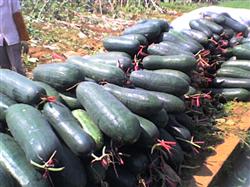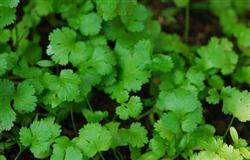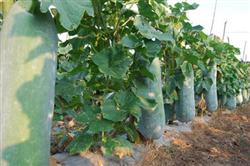Key points of wax gourd cultivation in small arch shed in early spring

Wax gourd is the main summer soup dish in summer and autumn. Wax gourd is cultivated in small arch shed in early spring in Xingtai area. It is on the market in mid-late June and lasts until mid-late September with long supply time and high yield. The main points of its cultivation are introduced as follows: first, the variety selection is generally selected Guangdong black-skinned wax gourd with disease resistance, high yield and heat resistance. Second, sowing seedlings in Xingtai area mostly use solar greenhouse or small greenhouse nutrition bowl to raise seedlings, the size of nutrition bowl is 10 cm × 10 cm. Proportion of nutrient soil preparation: fully mature organic fertilizer accounts for 70%, field soil that has not grown vegetables accounts for 30%, fully mixed and loaded into a nutrition bowl, and then watered thoroughly to wait for sowing. The sowing time of wax gourd in Xingtai area is generally controlled from February 10 to 15, and the temperature is controlled at 23 ℃ ~ 25 ℃ in daytime and above 15 ℃ at night. When the seedling age is about 40 days, the seedlings begin to colonize when they have 4 leaves and 1 heart. Third, planting buckle shed 1. Fertilize. Fully mature chicken manure 2000 kg and 54% ternary compound fertilizer 30 kg per mu were applied, ploughed evenly after application, and then watered, covered with plastic film after 3-4 days, waiting for planting. two。 Reasonable planting. In Xingtai area, it is generally from late March to early April, when the seedlings are 4 leaves and 1 heart, they are planted by a single plant with a distance of 60 cm, with 350 plants per mu. Then use the kettle to order water, insert a piece of bamboo every 1.3 meters, and buckle the film in time to be tightly compacted. The greenhouse film is 0.025 mm thick and 200cm wide. Fourth, field management 1. Buckle shed period management. The initial stage of planting was not ventilated, which promoted the growth of slow seedlings and roots. After slowing down the seedlings, the release should be carried out according to the weather conditions, and with the increase of the external temperature, the vent should be bigger and bigger, and the release time should be longer and longer. In Xingtai area, the greenhouse film was generally removed on May 1 and turned into open field production. two。 Fertilizer and water management. Buckle shed period is generally not watered, after removing the film combined with the introduction of vines, pressure vines, can be watered for one time. Flowering and fruiting period is generally not watered, so as not to melt melons. After the melon sits, the fruit stalk naturally droops "bend the neck", fertilizer and water attack together, with 40% compound fertilizer 20 kg per mu. After that, water was watered every 7 to 10 days, and fertilizer was applied once in about 15 days. The amount of topdressing was determined according to the growth of wax gourd. 3. Plant adjustment. Sitting melon before the introduction of vines, pressure vines, and remove all side branches, after sitting melon let its natural growth, not pruning and branching. 4. Pest control. The main diseases and insect pests of wax gourd are virus disease, powdery mildew, aphids and so on. 20% morpholine hydrochloride 500x solution can be used to control virus disease, 15% powder rust 500x solution can be used to control powdery mildew, and 20% imidacloprid 1000 times solution can be used to control aphids. 5. Harvest: the wax gourd in the small arch shed is generally picked and listed after June 15 when the single melon weighs more than 5 kilograms. Until the middle and late September, the yield per mu can reach 5000 kilograms.
- Prev

High-yield management techniques and key points of big leaf coriander
The improved varieties were selected from Japanese large-leaf coriander, Thai large-leaf coriander and Beijing large-leaf coriander. Suitable sowing shed cultivation, all seasons can be arranged for sowing, summer short-term cover sunshade net. Open field sowing began in late April, late June listed. Sowing in May, 1 m ahead of schedule on both sides of the mat bed.
- Next

How to fertilize wax gourd effectively
According to the principle of fertilization, wax gourd is suitable to grow in sandy soil rich in organic matter, is resistant to fertilizer and barren, and requires comprehensive nutrients such as nitrogen, phosphorus, potassium, calcium and so on. Base fertilizer should be re-applied and reasonable topdressing should be applied. The uptake of nutrients was less in seedling stage, more in bolting stage, and in flowering and fruiting stage, especially in early and middle stage of fruit development.
Related
- Where is it suitable to grow horseradish in China? it is expected to see the middle altitude horseradish in Alishan.
- How to prevent tomato virus disease reasonably? (Control methods included)
- Many people like to plant towel gourd on the balcony. What are the main points of this method and management?
- What crops can chili peppers be mixed with?
- Fertilization techniques and matters needing attention in Tomato
- What are the grafting techniques for peach seedlings in spring?
- Harm and control methods of root swelling disease of Chinese cabbage
- What are the pests of sweet potatoes? How to prevent and cure it?
- Symptoms, causes and Control methods of navel Rot in Tomato
- The cause of "Cucumber rotten bibcock" in Farmers' planting Cucumber and its Control Plan

